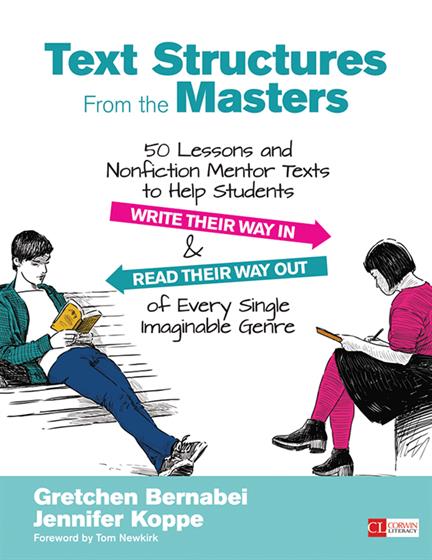Foreword by Tom Newkirk
Introduction
Acknowledgments
Lesson 1
Structure: Stepping Up to a New Role
Source Document: Hippocratic Oath, 400 BCE
Lesson 2
Structure: Can't We Just Get Along?
Source Document: Speech to Captain John Smith, Chief Powhatan, 1609
Lesson 3
Structure: Team Promise
Source Document: Mayflower Compact, 1620
Lesson 4
Structure: Humble Request for Help
Source Document: Plymouth Plantation, 1624
Lesson 5
Structure: No, Thank You
Source Document: Letter to William and Mary College, The Indians of the Six Nations, 1744
Lesson 6
Structure: Lighting a Fire Under a Procrastinator
Source Document: Speech, Patrick Henry, 1775
Lesson 7
Structure: How Bullying Works
Source Document: "Journal of a Lady of Quality," Janet Schaw, 1775
Lesson 8
Structure: Problem-Solution Message
Source Document: Declaration of Independence, 1776
Lesson 9
Structure: Time for a Real Solution
Source Document: Common Sense (Excerpts), Thomas Paine, 1776
Lesson 10
Structure: Letter From Home
Source Document: Letter to Her Husband John Adams, Abigail Adams, 1776
Lesson 11
Structure: How Bad Is It? (A Description)
Source Document: Letter to George Washington, Benjamin Rush, 1777
Lesson 12
Structure: Reprimanding a Group
Source Document: Speech to Angry Officers, General George Washington, 1783
Lesson 13
Structure: Purposes of an Action
Source Document: Preamble to the Constitution, 1787
Lesson 14
Structure: Charm Check
Source Document: "The Star Spangled Banner," Francis Scott Key, 1814
Lesson 15
Structure: S.O.S.
Source Document: "Victory or Death" Letter From the Alamo, William B. Travis, 1836
Lesson 16
Structure: Sightseeing
Source Document: "Observations on a Steamboat Between Pittsburg and Cincinnati," American Notes, Charles Dickens, 1842
Lesson 17
Structure: Tour of an Unfamiliar Place
Source Document: "Factory Life," Labor Reformer, 1846
Lesson 18
Structure: Breaking Into a Heated Argument
Source Document: "Ain't I a Woman?" Speech, Sojourner Truth, 1851
Lesson 19
Structure: Controversial Decision
Source Document: Emancipation Proclamation, Abraham Lincoln, 1862
Lesson 20
Structure: At the Moment of a Milestone
Source Document: Gettysburg Address, Abraham Lincoln, 1863
Lesson 21
Structure: We're Both Wrong; We're Both Right
Source Document: Second Inaugural Address, Abraham Lincoln, 1865
Lesson 22
Structure: Letter to an Author
Source Document: Letter to Harriet Beecher Stowe, Frederick Douglass, 1868
Lesson 23
Structure: Fighting Unfairness With Logic
Source Document: “Women’s Rights to the Suffrage" Speech, Susan B. Anthony, 1873
Lesson 24
Structure: Valuable Advice
Source Document: "Advice to Youth" Speech, Mark Twain, 1882
Lesson 25
Structure: Comforting a Friend in Pain
Source Document: Letter to a Friend, Henry James, 1883
Lesson 26
Structure: I Want More (While I Have the Chance)
Source Document: Letter to Professor Baird, William G. Hornaday
Lesson 27
Structure: First Earnings
Source Document: Hard Times Cotton Mill Girls (Excerpt), Bertha Miller, b. 1890
Lesson 28
Structure: My Symbol
Source Document: The Pledge of Allegiance, 1892
Lesson 29
Structure: Narrative: Just the Facts
Source Document: On Lynchings (Excerpt), Ida B. Wells-Barnett, 1895
Lesson 30
Structure: Letter of Recommendation
Source Document: Letter to Jessie Gladden, Clara Barton, 1898
Lesson 31
Structure: Why Something Goes Viral
Source Document: "A Modern Day Devil Baby" (American Journal of Sociology, 20(1), (117–118), Jane Addams, 1914
Lesson 32
Structure: Understanding the Scars of Our Elders
Source Document: "Remembering Slavery" (Excerpt), Tonea Stewart, 1930
Lesson 33
Structure: Objects of Affection
Source Document: "The Pleasure of Books," William Lyon Phelps, 1933
Lesson 34
Structure: True or False? Neither
Source Document: Letter From Phyllis, Albert Einstein, 1936
Lesson 35
Structure: How an Experience Changed Me
Source Document: It's a Great Life, Robert L. Miller, 1937
Lesson 36
Structure: A Bad Situation a Lot of Us Are In
Source Document: "I'd Rather Not Be on Relief," Lester Hunter Song, 1938
Lesson 37
Structure: Picking Up the Pieces
Source Document: Pearl Harbor Address to the Nation, Franklin Delano Roosevelt, 1941
Lesson 38
Structure: Heads Up From Your Wingman
Source Document: Letter to Her Husband, Eleanor Rooseevelt, circa WWII
Lesson 39
Structure: What Do I Mean? Well . . .
Source Document: "I Love You" Letter, Ayn Rand, 1948
Lesson 40
Structure: My Advice About Your Strong Feeling
Source Document: Letter to His Son Thom, John Steinbeck, 1958
Lesson 41
Structure: Pep Talk
Source Document: Inaugural Address, John F. Kennedy, 1961
Lesson 42
Structure: Memory Reflection
Source Document: Black Like Me (Excerpt), John Howard Griffin, 1961
Lesson 43
Structure: Parting Advice to Your Replacement
Source Document: "Duty, Honor, Country," General Douglas MacArthur, 1962
Lesson 44
Structure: Bon Voyage
Source Document: Letter to His Astronaut Son, Scott Carpenter, 1962
Lesson 45
Structure: I Feel Your Pain
Source Document: "Ich bin ein Berliner" Speech, John F. Kennedy, 1963
Lesson 46
Structure: Flashpoint Moment of Truth
Source Document: "And We Shall Overcome" Special Message to Congress (Excerpt), Lyndon B. Johnson, 1965
Lesson 47
Structure: Walking the Walk to Make a Difference
Source Document: "Lessons of Dr. Martin Luther King, Jr.," Cesar Chavez, 1990
Lesson 48
Structure: Using a Story to Make a Point
Source Document: Nobel Lecture (Abridged), Toni Morrison, 1993
Lesson 49
Structure: New Perspectives From a Photo
Source Document: "Pale Blue Dot" Speech, Carl Sagan, 1996
Lesson 50
Structure: So You'll Know Me After I'm Gone
Source Document: Letter to My Sons (Preface), Lieutenant Colonel Mark Weber, 2012
Appendices
1. Complete Collection of 50 Text Structures
2. Text Structures Useful as Promises to Others
3. Text Structures of Our Identity
4. Text Structures for Travel
5. Text Structures for Important Moments
6. Text Structures for Desperation
7. Text Structures Useful as Persuasion About Some Needed Change
8. Text Structures Useful for Bad Times
9. Text Structures for Times of Conflict
10. More Ways to Use the Lessons in an English Language Arts Classroom
11. More Ways to Use the Lessons for Academic Play in a Social Studies or History Classroom
12. Character Project Assignment and Tracking Sheet




